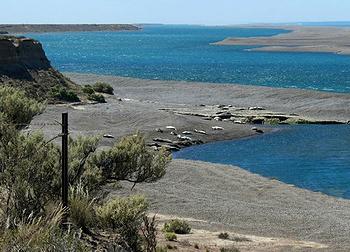
SANTIAGO, Chile, September 25, 2017 (ENS) – Chilean President Michelle Bachelet has pledged to create a new marine protected area in Admiralty Sound in Tierra del Fuego at the tip of South America.
The new “Multiple Use Marine and Coastal Protected Area Seno Almirantazgo” will safeguard marine wildlife and the area’s cultural heritage, while protecting artisanal fisheries and promoting sustainable tourism.

The newly declared protected area contains leopard seals, elephant seals, black-browed albatross, Magellanic penguins and other wildlife.
Admiralty Sound, along with two other marine parks – Francisco Coloane and Cape Horn – will become the core of a network of Marine Protected Areas, MPAs, for the Magallanes Region, the southernmost, largest, and second least populated of Chile’s regions.
The announcement was made on September 9 during the 4th International Marine Protected Areas Congress (IMPAC4) hosted by Chile. President Bachelet announced plans to protect 46 percent of the Exclusive Economic Zone of Chile.
Said President Bachelet, “We are becoming the country with the largest marine area protected in the world – a developing country that can be a leader in conservation. This is not a triumph of the government, it is a triumph of reason.”
Admiralty Sound, or El Seno Almirantazgo, is a spectacular, 80 kilometer (50 mile) long fjord adjacent to Karukinka Natural Park, a large protected area owned and managed by the Wildlife Conservation Society, a New York-based nonprofit organization that manages five New York City wildlife parks and maintains 500 field conservation projects in 65 countries.
The sound was discovered in 1827 by the British Captain Phillip Parker King and named after the British Admiralty.
The fjord cuts deeply into the west coast of the Isla Grande de Tierra del Fuego. On its south side smaller fjords and bays make indentations into the north coastline of the Cordillera Darwin. One of these, Ainsworth Bay, is home to a colony of elephant seals. The Azopardo River empties into the head of the fjord.
The sound was first proposed as a protected area by WCS Chile to the Ministry of the Environment in June, after a decade of collaborative research, education and conservation work integrating multiple stakeholders in its design.
The protected area has the support of the governor of the Magallanes Region, the regional representative of the Ministry of Environment, the local governor of Tierra del Fuego, communal authorities of Timaukel and Porvenir, local fishing unions, and Karukinka neighbors.
The area needs protection. Two introduced mammals threaten the biodiversity of the fjord: the beaver, which builds dams in the rivers and streams of Tierra del Fuego, destroying forests and altering watercourses that reach the sea; and the mink, which feeds on seabird eggs and chicks, making life tough on the albatross colony of the Albatross Islet, the only known colony that nests and feeds in inland waters.
In addition, the Sound, acting like a funnel of sea and wind, receives tons of marine debris including plastic bags, ropes, nets, and bottles, where it negatively impacts both marine life and tourism.
At the same time, unregulated tourism can be a disturbance to natural life, causing abandonment of nests and migration of colonies to more protected sites, with serious consequences in their conservation.

WCS Chile Country Director Bárbara Saavedra said, “This announcement of the first MPA in Tierra del Fuego will become a model for effective management of coastal conservation.”
Said Alejandra Figueroa, Head of the Natural Resources and Biodiversity Division at Ministry of the Environment, “The conservation of the Admiralty Sound is a collaborative workspace where WCS is leading an integrated marine and land strategy that will allow us to work together with fishermen, tour operators and other actors, based on adequate and sustainable management.”
By protecting Seno Almirantazgo, the Chilean government is officially launching the Magallanes Network of Marine Protected Areas, first announced in 2015, which is expected to expand across the Patagonia region.
The MPA network will enable Chile to meet its target of protecting 10 percent of relevant ecosystems by 2020, a goal in keeping with the Aichi Biodiversity Targets that are part of the Convention on Biological Diversity.
While Chile’s marine protected areas already span 13 percent of the ocean under national jurisdiction, some ecosystems are under-represented. The Channels and Fjords Ecoregion of Southern Chile, the most pristine region of the country, has less than one percent of its seas protected.
The Network of Marine Protected Areas for Patagonia is a collaborative effort leaded by the Government of Chile and involving the work of various organizations including WWF, Fundación Huinay, Fundación Meri, Centro Ballena Azul, National Geographic’s Pristine Seas Program, and WCS Chile.
Copyright Environment News Service (ENS) 2017. All rights reserved.
© 2017, Environment News Service. All rights reserved. Content may be quoted only with proper attribution and a direct link to the original article. Full reproduction is prohibited.
